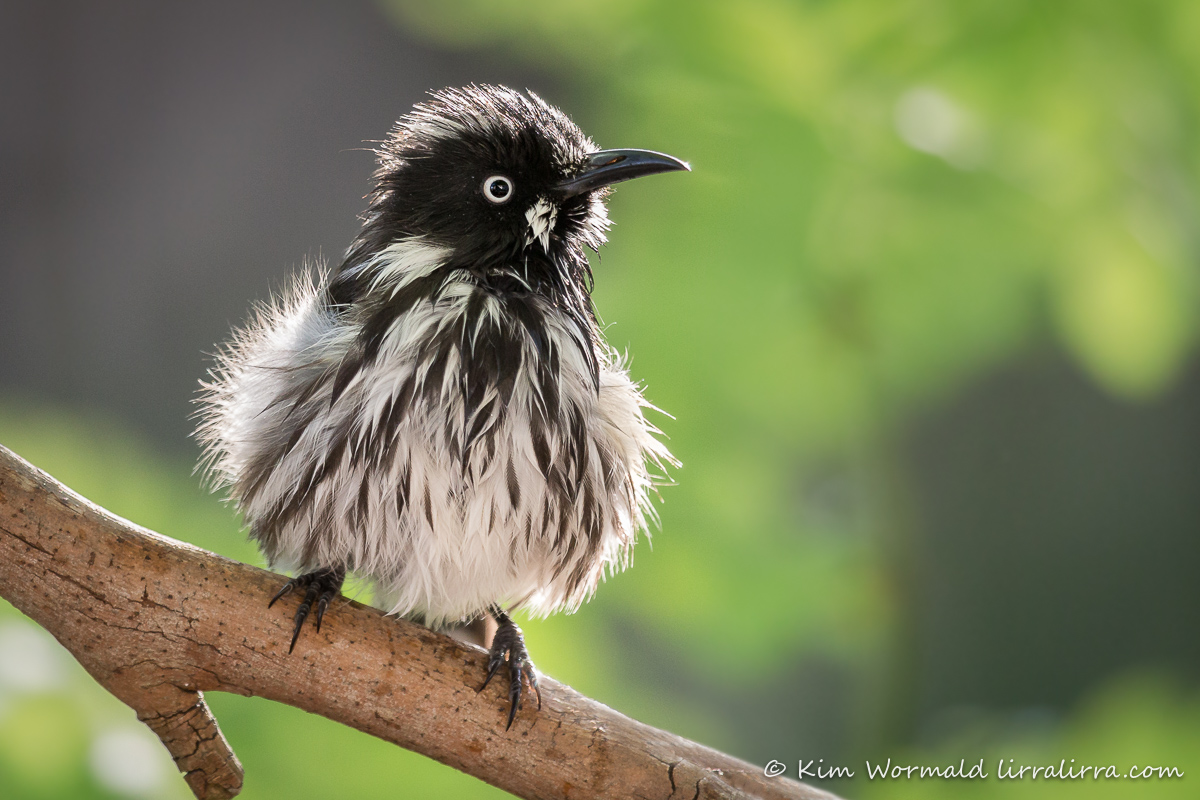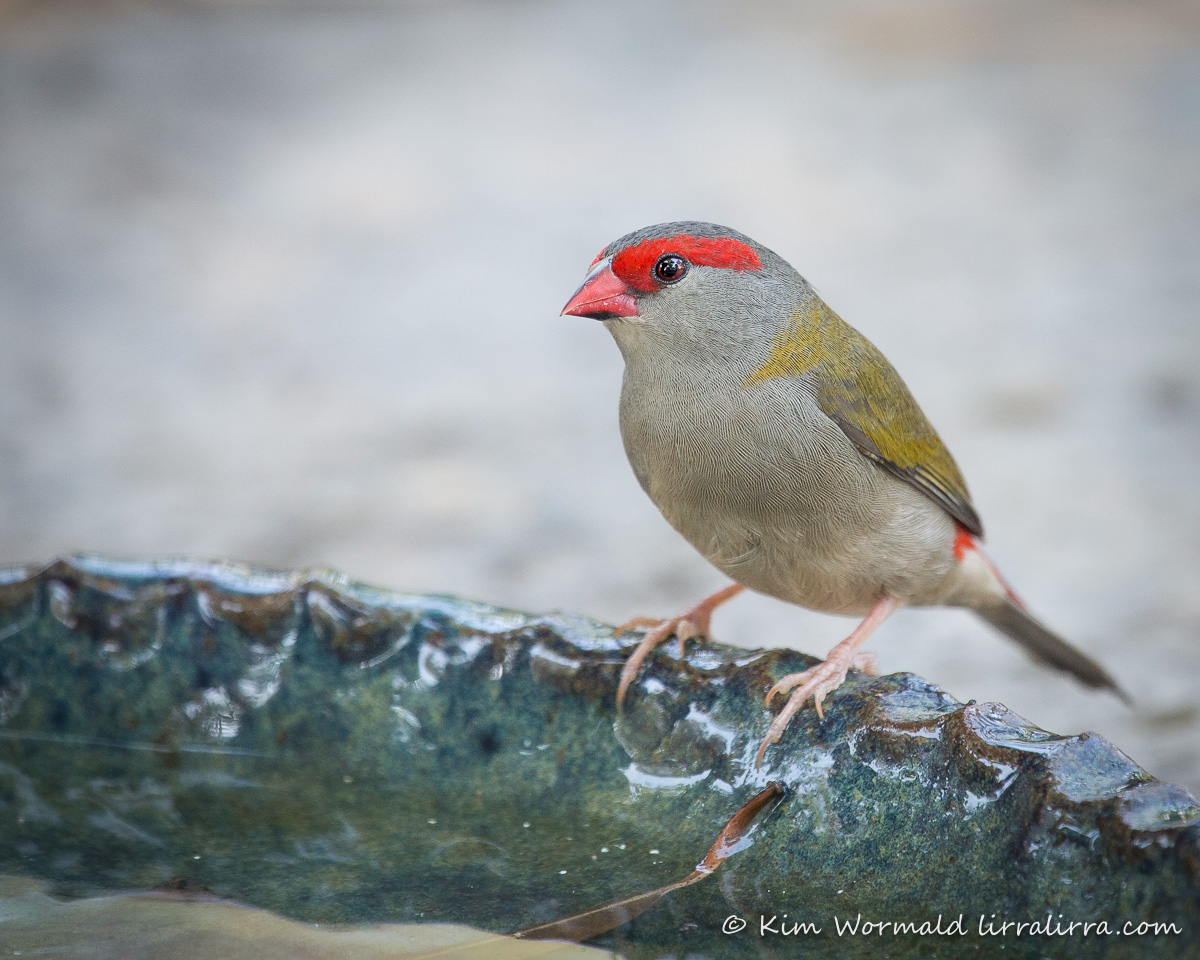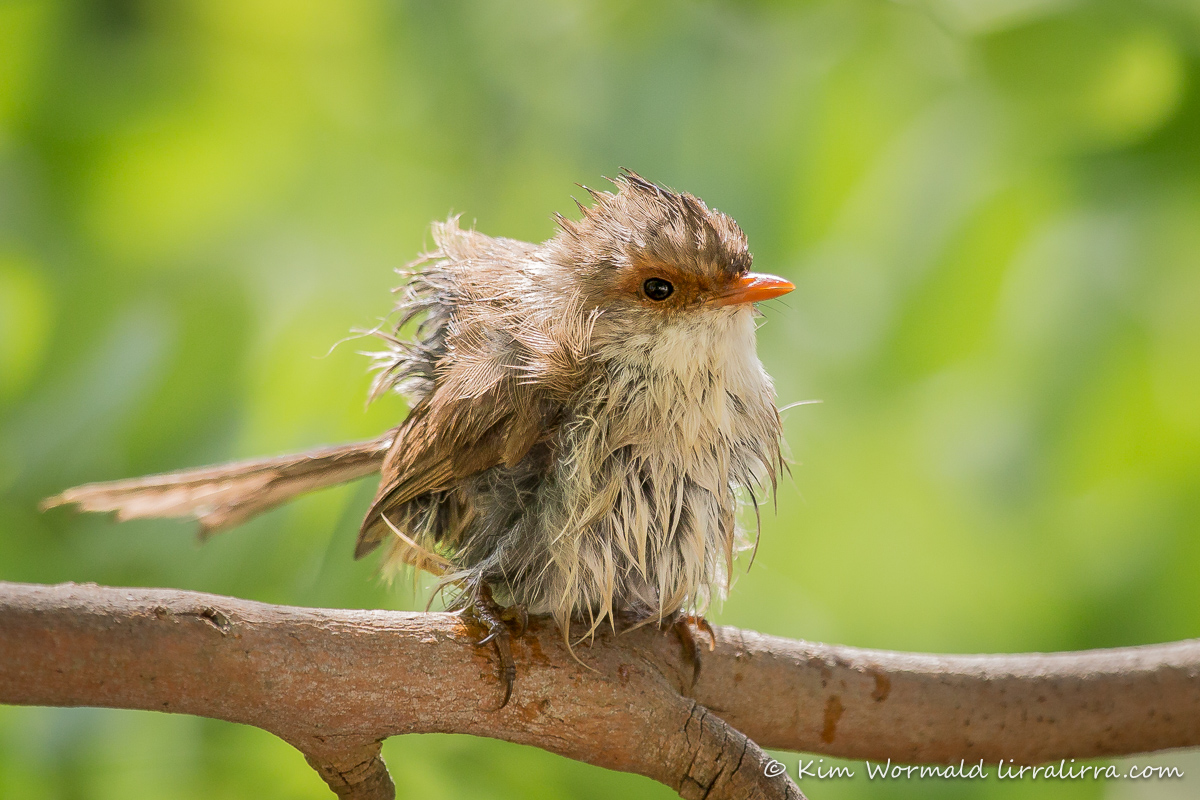It reached 43 degrees Celsius here today, that’s 110 degrees Fahrenheit – and the birds suffered.

New Holland Honeyeater
I have three birdbaths clustered among shrubs and small trees; two are shallow while the third is deeper with rocks in it to ensure that small birds are able climb out when they’re wet. This week’s images were taken a while ago. This morning I turned the hose onto a drip and then closed the spray so tightly that it sent a small, fine spray into one of the baths – the birds loved it and I loved watching them.

Red-browed Finch
There was constant activity at the baths today. I noted seventeen species, often several species shared the water at the same time while others sat among the foliage waiting their turn. Heat stressed birds held their bills open, panting to try to cool themselves.

Superb Fairy-wren
I saw a pair of Eastern Spinebills fighting, rolling on the ground as they squabbled. I have seen Superb Fairy-wrens fighting over territory so presumed the spinebills were also being territorial. It was awful to see them wasting energy in such heat. A Grey Fantail was flying across the grass towards the water when it fell out of the sky, landing on its back. After a few moments it recovered enough to continue its journey.
Fantails and Golden Whistlers are nesting here at the moment. Adults of both species bathed frequently and I hope they used their wet feathers to cool their nestlings.
Providing water for our wildlife makes a huge difference to their wellbeing. I was transfixed as I watched them today. I chose not to photograph the birds in the heat as I didn’t want to risk disturbing them, it was probably a good decision for me too.
Happy birding
Kim
NB further information regarding birdbaths and hot weather can be found at: Water birds and waterbirds
PS I forget to mention that a selection of my images can still be seen at The Chosen Bean, Mountain Gate, Ferntree Gully until the end of the month
~ thank you for visiting and commenting
~ if you would like to join the subscribers receiving a weekly email when lirralirra is updated, please use the ‘subscribe’ box above right

I was so pleased to be able to watch a bunch of wrens bathing in the lid of wine keg, left outside, last week. Only difference was it was 3 degrees Celsius (warm for some countries). They are tough little birds, and beautiful to watch. Thanks for sharing.
Oh Syndy I’ve only just seen this comment! What a beaut sight your wrens would have been in the wine keg lid. Aren’t birds amazing that they can bathe in the heat and the cold, shivers 🙂
Hi. I have several birdbaths near the house and regularly have all sorts of birds drinking and bathing. However, every day several Purple Swamphen stand in them and soil them to the extent that they end up like pea soup. I clean and refresh them every day, but wonder how long that lasts for. I have thought about wire, but I don’t want to stop other larger birds having a drink, which they regularly do, like the Yellow-tail Black-cockatoos, Eastern and Crimson Rosellas, King Parrots, Lorikeets, Buff-banded Rails, Corellas, Little Wattlebirds, Peewees and Magpies, Blackbirds, even occasional Satin Bowerbirds getting in. I get Brown and Yellow Thornbills, Wagtails, Fantails, Superb Fairwrens, Spinebills, Red-browed Finches, Yellow-faced, Lewins, and New-holland Honeyeaters – all photographed, and others I can’t recall off the top of my head.
Does anyone have any suggestions as to how to selectively keep Purple Swamphen out of the bird baths? They graze like fleas on a dog on the 1 hectare I keep dog free for birds, having planted heaps of natives and trees, and roost each night on an island in the middle of a large pond which is on one side of the property.
I realise they would have evolved to defaecate in the pond where it causes no problem, and don’t realise it is unacceptable behaviour in the birdbaths, but that doesn’t make it nicer for all the other birds!
Thanks
Andrejs
What a lovely problem you have Andrejs – too many birds visiting your birdbaths! Your property sounds wonderful. All I can think of is to provide the swamphens bath on the ground and the other birdbaths higher up, or nestled among the plants so they are less accessible to the swamphens. If you’re on facebook the members of the Field Nats page, or Birds in Backyards page, might be able to make other suggestions. I hope all goes well with whatever you try, Kim
I had placed a birdbath on a little-used verdana on our home several months ago.
It’s a roofed porch, on the 2nd level, with no straight access…perfect for a safe bath.
My home office is just outside and I can watch all day long. (beats working)
I am amazed at what a gathering spot it is. Bathing, drinking, and socialising of all kinds.
They used to be fearful of my head in the window watching, now I can stand and they seem to know I’m okay.
I seems they know I am the one that takes care of the water.
Once a day, the water is dumped, wiped, and refreshed….I’m hooked on helping in this small way.
(I have thought about providing small bathrobes and slippers for my birdie Spa)
Thanks for your site. Very informative, and beautiful photos, I’m hooked
Regards
What a fantastic set up! It sounds like the perfect way not to get much work done. Your idea of little bathrobes and slippers made me chuckle. I’m glad you’re enjoying lirralirra Fred, thank you for your beaut comments and for caring about the birdlife
Wow indeed! What gorgeous photos. Well done!
Thank you Country Mum
love the photos, you capture the character of the birds. And i fully agree with all your advice. is there anything we can do to help a little finch mother and her four babies that are suffering in the heat and thick smoke from tas fires? i don’t know if the mother would eat fruit or would she like a worm dropped on the edge of the nest? i know nature is great at caring for itself but they are so little and i’ve been reading of many little babies people have been observing have died this summer. can a mother finch lift a dead baby out of the nest?
can i quietly sneak up and spray a fine mist of cool water over the wisteria? thank you for any advice, Sally
I have a similar dilemma here as I mentioned in the post. Depending on the age of the babies they could leave the nest in fright if you went too close, and making a one-way path to the nest can alert predators. I decided that the best I can do is to keep cool water available for the adult birds to bathe in. A few years ago I tried to finely spray a family of ducks that were suffering in the heat, even though I was a long way from them they were disturbed by the spray and flew away – instead of making things better I made them worse. Finches eat mainly seeds but they do also take fruit so maybe you could leave some near the water. I don’t usually recommend feeding native birds so am not sure whether this is good advice though due to the circumstances I don’t think it could hurt. They wouldn’t be interested in a worm. Maybe Bonorong Sanctuary would some better ideas. I wish you all the best Sally, please let me know how they go, Kim
I am so glad that you have plenty of water baths for the birds. The ones we put out have been largely rejected. So we have ensured that there are apples and food in the shade. I am not certain why the water has been rejected (except by pigeons). Too much movement, too many local cats and dogs? I have been watching the heat-stressed birds here in horror. And have taken a few photos (through the windows). I do hope cooler times are coming.
I’m wondering about your birdbaths EC, I’m glad that at least the pigeons have been making use of them. If you get a minute could you let me know what kind you use, where they are placed, how deep they are – that kind of information. Maybe there will be something simple you could change that would make them more appealing.
We have trialled a range of baths. Most are relatively shallow, because I hate the thought of a bird unable to get out of the water. We do our best to put them in at least partial shade, but ensure that the birds can see around them – there are a lot of cats in the area. Plastic ones, wooden ones, some at ground level, some higher. And the most successful is a nasty yellow plastic dog dish which lives on the veranda.
How funny about the yellow dish. It sounds like the issue is probably the cats, what a shame. In my shire there is a cat curfew and cat confinement regulation stating that cats have to be confined to their own properties and have to be inside at night – that’s the theory anyway and it’s certainly helping the birds. If the higher bird bath is out of the reach of cats then maybe the openness is part of the problem. Birds are so vulnerable when they’re wet that they like to hop straight out of the water onto a sheltered perch or among foliage to shake and preen. The smaller birds often bathe in groups so will have a lookout posted. At very open birdbaths the bathers are vulnerable to attack from raptors like goshawks and sparrowhawks. It’s lovely that you are sharing so much water with the wildlife, I wonder whether possums etc pop in for a drink during the night.
Oh Wow!
🙂
Gorgeous images, I particularly love the wet and bedraggled wren! It’s a timely reminder how important it is that we all have dishes of water out for wildlife throughout summer.
It really does look bedraggled!